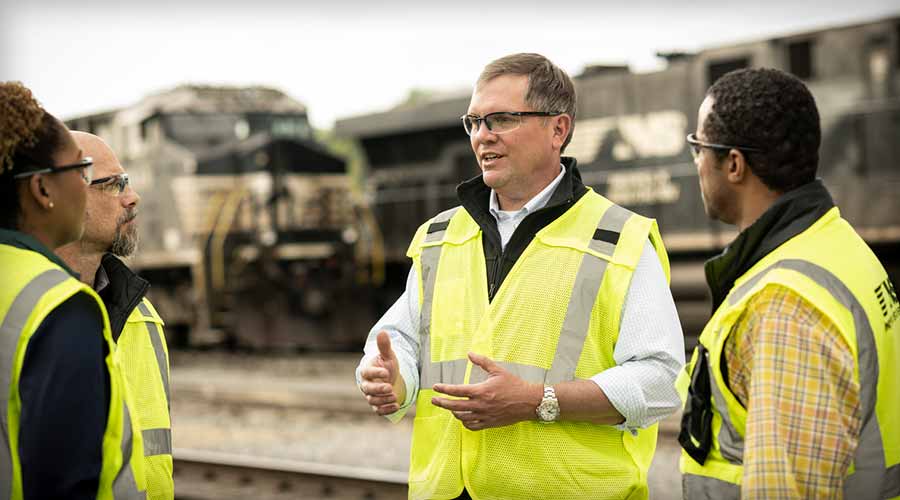NS pursues 'resilience railroading' as part of new service-disruption strategy
12/20/2022
By Jeff Stagl, Managing Editor
Nearly every day, railroads deal with operational disruptions caused by severe weather, equipment outages, infrastructure issues and other factors.
On top of that, they face service-disruption cycles that surface every three to four years because of a number of hard-to-predict developments, such as regional labor shortages, freight surges or rolling-stock supply issues.
In the short term, such disruptions drive up operating costs and substantially limit volume-growth opportunities. And in the long term, they can erode shippers’ confidence in relying on rail versus trucks.
Although railroads have become operational-interruption veterans, most weren’t prepared for the pandemic-driven disruptions that occurred over the past two-plus years, such as the deep pullback then sudden resurgence of freight demand combined with a lingering labor shortage.
Norfolk Southern Railway was one of the unprepared, but now is taking steps to ensure recent history doesn’t repeat itself. The railroad is pursuing “resilience railroading,” a term it coined as part of a new operational strategy.
The ultimate goal: to constantly provide reliable and resilient service; drive continuous productivity improvements; and prompt smart and sustainable business growth over the long term through various initiatives and investments, including an effort to improve workforce development.
 During the Class I’s annual Investor Day on Dec. 6, several NS senior executives described the reasons for and benefits to be derived from a new resilience railroading strategy. Norfolk Southern Railway
During the Class I’s annual Investor Day on Dec. 6, several NS senior executives described the reasons for and benefits to be derived from a new resilience railroading strategy. Norfolk Southern Railway NS has found its traditional approaches for dealing with service-disruption cycles — such as by temporarily furloughing surplus employees and limiting spending when demand drops — didn’t work well in the past. When the time came to rebuild the workforce as freight demand rebounded, the railroad couldn’t rehire furloughed employees fast enough to operate fluidly.
If the railroad furloughed 5% of its train and engine-service (T&E) workforce for a year because of a market downturn, the company could save about $35 million or 30 basis points for its operating ratio, said NS President and CEO Alan Shaw Dec. 6 during an address at the Class I’s investor conference. But when the market rebounded, only about 45% of the furloughed employees would return when recalled.
“We would have to hire new conductors to replace the more than half that don’t come back, which would take at least six months once the process starts,” Shaw said. “This would cost about $10 million, since it costs approximately $50,000 to recruit, hire and train a new employee.”
Resiliency is broad set of balanced approaches
What’s even more impactful to NS: service disruption costs resulting from a volume resurgence the railroad isn’t equipped to handle. Such costs can reach as high as $160 million per year.
“Resilience is an investment in long-term shareholder value. There is a return, it is significant, and it doesn’t take long to achieve,” said Shaw. “Although some have spoken about resilience in terms of furlough avoidance, we believe long-term resiliency is about much more than furloughs. It is a broad set of balanced management approaches that include alternatives to traditional furloughs.”
Resilience also has a deeper importance to NS than an ability to handle future disruptions resembling those caused by the pandemic.
“A company can’t expect to provide sustainable growth if it provides its customers with a lousy service product every three years. By giving our customers a reliable service product that is also consistent, we can structurally shift a larger fraction of America’s freight away from the highway,” said Shaw. “We [have built] a financial model of what resilience would mean over the long term for Norfolk Southern.”
Changing the Class I’s workforce strategy during economic downturns will help the company build stronger relationships with its craft employees and improve their quality of life, he believes. A new workforce management strategy is designed in part to take conductors off the railroad and provide them with fixed work locations with more predictable schedules.
“In relatively short economic downturns, we will take the opportunity to provide additional training and development for our craft employees. Examples include qualifying our people to operate over additional territories and investing in employees by training them to be locomotive engineers, a process which takes about six months,” said Shaw. “This will improve our operational flexibility and the productivity of our workforce.”
The railroad also is trying to harness more mobile technologies to empower its workforce and make routine administrative functions easier.
“We are leveraging technology that will one day mean our people won’t need to walk the length of a mile-long train, at night, in Chicago and in the winter, to inspect for potential defects,” Shaw said.
To drive resilience, the Class I is seeking a more balanced T&E workforce staffing strategy and better forecasting. That will be the payoff of a new “game-changing” workforce planning model and full-cycle approach to maintaining more consistent staffing no matter the economic conditions, said NS Executive Vice President and Chief Transformation Officer Annie Adams at the investor conference.
Working closely with subject matter experts from the marketing, operations, human resources and labor relations departments, the railroad’s data science and operations research team members are developing a model designed to integrate customer demand forecasts and workforce planning, and leverage predictive analytics to continually forecast staffing needs for each of NS’ 95 hiring locations.
Improved visibility into future staffing needs will better prepare the company to handle new business and demand surges, and provide critical staffing insights, Adams said.
“We are going to take an approach that balances service, productivity and growth, which will result in more consistent staffing levels over time. And that approach will drive engagement and retention as we build stronger relationships with our craft workforce,” she said.
There might be economic downturns severe enough to induce staffing reductions, but in those cases, the railroad will explore alternatives to traditional furloughs to maintain a connection with employees and incentivize them to return when volumes pick up, Adams said.
“The goal in all of these scenarios is to ensure that when business rebounds, we are positioned to quickly redeploy a more skilled, engaged and productive workforce so that customers have the confidence to tightly integrate us into their supply chains,” she said. “We [also will be] positioned to take full advantage of the profitable volume opportunities in the early stages of economic recovery.”
In addition, NS leaders hope to reduce the volatility of investing in assets with long-term strategic value — including locomotives, track, sidings, intermodal terminals, technologies and people — through more balanced and consistent targeted investments.
“By taking a longer-term view and having more consistent business, we can better project capacity needs and be more planful in our investments to meet those needs,” said NS spokesman Tom Crosson in an email.